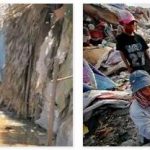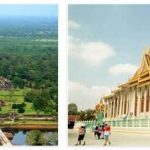(Preǎhréachéanachâkr Kâmpǔchéa). State of Southeast Asia (181,035 km²). Capital: Phnom Penh. Administrative division: provinces (20), municipalities (4). Population: 16.069.921 residents (2018 estimate). Language: Khmer (official), French. Religion: Buddhists 93%, Muslims 4%, Christians 2% others 1%. Monetary unit: riel (100 sen). Human Development Index: 0.582 (146th place). Borders: Laos (N), Thailand (N and W), Viet Nam (E and SE), Gulf of Siam (SW). Member of: ASEAN, UN and WTO. Source: localtimezone
THE STATE
Cambodia achieved independence in 1953 (ratified by the Geneva International Conference in 1954). Formerly a constitutional monarchy and presidential republic, in 1979 it took on the name of the People’s Republic of Cambodia. The current constitution, promulgated in 1993, restored the monarchy and established a bicameral Parliament, formed by the National Assembly (122 members elected by universal suffrage) and the Senate (61 members, elected by local administrative councils). The government needs the trust of two thirds of the Assembly. The monarchy is not hereditary: the major authorities of the country, gathered in a Council of the crown, are responsible for the election of the king. The judicial system, reformed on the basis of the new Constitution, provides for three levels of judgment; the last level is represented by the Supreme Court of Magistrates. The system of law in use derives from the mixture of codes of French influence, royal decrees, legislative acts and customs deriving from the communist system. The jurisdiction of the International Court of Justice is still accepted with reservations. The country’s armed forces are divided into the three traditional weapons, to which are added several provincial forces. The military service is compulsory and lasts 18 months. The Cambodian school system provides for primary education (free and compulsory) lasting 6 years, starting from the sixth year of age and secondary education, optional, which instead includes two cycles, each of 3 years. Higher education is given in several technical institutes and at the University of Phnom Penh. The country’s illiteracy rate in 2015 concerned almost one fifth of the population (19.5%); the figure, quite high, reveals an even more marked disparity between the literacy rate of adult men and women (64% against 85%).
TERRITORY: MORPHOLOGY
Territorially, Cambodia has its own relative physical unit. It is centered on a large depression, which for the most part falls within the lower basin of the Mekong, and is between the southern offshoots of the Annamite Range to the E and some low reliefs (Dong Rak Range and Cardamom Mountains) which surround it respectively. NW and SW, where the country pushes its borders to the coast of the Gulf of Siam. In the reliefs the ancient Paleozoic formations emerge, dominated by strips of the Mesozoic: the latter represent the remains of the sedimentary covers accumulated when the Cambodian depression was occupied by the sea. For 80% of its surface the Cambodian territory, a few meters above sea level, is covered by the recent river floods of the Mekong, here attracted by the depression, structurally a large syncline. It has its most depressed part in the Tonle Sap, a lake surface with changing contours, seasonally invaded by the waters of the Mekong, through a branch that branches off in Phnom Penh from the main course of the river.
Khmer literature
Khmer literature. With the fall of the Angkor Empire (1st half of the 15th century), the ancient Khmer literature, recorded on perishable material, was lost. The only surviving literary testimonies of that time are the “Ream Ker” (The Call of Ramas), an independent adaptation of the “Ramayana” and the “Trai Phum” (The Three Worlds), the fragmentary version of a Mahayan-influenced cosmogony from the end of the Khmer Empire.
In the post-Angkorian period the scriptures of Buddhism (“Tipitaka”) were translated into Khmer. Angkor’s literary traditions were resumed at court. King Preah Reach Samphear wrote numerous works. The wealth of Khmer literature is made up of novels, songs and fairy tales.
Modern literature, influenced by Western ideas in the French colonial era, seeks the path to national self-reflection after Cambodia’s state independence has been preserved.
Expenditure:
Légends sur le Siam et le Cambodge, ed. v. C. Notton (1939); Fairy tales of the Khmer, ed. v. R. Sacher (new edition 1982).
Battambang
Battambang, capital of Battambang Province, Cambodia, west of Tonle Sap, (2008) 140 500 residents.
The province is known as the “rice province”, along with growing vegetables and jute; Textile factory; Phosphate degradation; University; Airport.
Sihanoukville
Sihanoukville [sianuk vil], Preah Sihanouk, formerly Kompong Som [k ɑ mpu Ə ŋ sa m], city in southern Cambodia, the Gulf of Thailand, (2008) 89 400 residents.
Tractor and truck assembly, etc. Industry; the only deep water port in the country, connected to Phnom Penh by rail and road; Airfield.
Founded in 1960.








